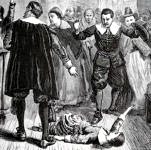1. The severely religious trend of thought, the barrenness of life, and the dangers from Indian attacks that impended about the year 1691, account for the occurrence in Massachusetts of the witchcraft troubles. The theory of Satanic manifestations was commonly held in European countries, and there claimed its thousands of victims. In Salem and surrounding towns, two or three hundred persons, some of them being of the highest character, were accused of having allowed themselves to become possessed by the devil. Of these, nineteen were judicially condemned and were put to death. The comparative brevity and mildness of this outburst of religious fanaticism testifies to the real sadness of the Puritan mind. Nowhere in the world at this time was life more pure or thought more elevated.
1912
2. Early in the year [1692], two children of the family of a clergyman in Salem village, the one eleven, the other nine years of age, having been for some time indisposed, and no relief being obtained from medical aid, the attending physician suggested the probability of their being bewitched. The children, informed of their supposed situation, complained of an Indian woman, and declared they were "pinched, pricked, and, tormented" by her. Other persons, soon after, afflicted with various complaints, attributed their sickness to the same cause; and several of the imagined witches were put in prison. In the month of June eleven persons were tried, condemned, and executed. The awful mania increased. In September, nine more received sentence of death. Each became suspicious of his neighbor. The charges of witchcraft, commencing with the lower part of society, extended to all ranks; even a clergyman, among others, having been executed. A confession of guilt became the only security for life; such not being condemned. In October, the number of persons accused was so great, and their standing in society so respectable, that by general consent, all persons were released, and all prosecutions dropped.
1823
3. The most plausible explanation may lie in the uncertainty of life in late seventeenth-century New England. Salem Village, a farming town on the edge of a commercial center, was torn between old and new styles of life. Some families were abandoning agriculture for trade, while others were struggling to maintain traditional ways. The villagers who exploited the new economic opportunities were improving their status relative to their neighbors. Most people were uncertain about their destiny, but none more so than adolescent girls. As children their fate lay in the hands of their parents, yet their ultimate destiny would depend on their husbands. But would their husbands be farmers or artisans or merchants? What would their future lives be like? No one knew. By lashing out and in effect seizing command of the entire town, the girls gave their lives a certainty previously lacking. At the same time, they afforded their fellow townspeople an opportunity to vent their frustrations at the unsettling changes in their lives. The accused witches were scapegoats for the shattered dream of an isolated Bible Commonwealth.
1982
4. In 1692, the supposed witchcraft broke out in Salem and Danvers. Here the first subjects of it were children. The disorder, whatever its character may have been, … [at first] affected the lower classes only; but at length it pervaded all ranks and conditions. Two daughters of a minister, in Salem, were strangely affected. Before this they had been quiet, happy children but now they began to look wild, shriek, tell strange stories, sit barefoot among the ashes, or go abroad with their clothes and hair in great disorder, looking like insane people. Sometimes they were dumb; at others they would complain of being pricked severely with pins. The madness continuing to spread… Those who confessed the crime of witchcraft, however, were not executed. It was indeed a fearful time. Multitudes were suspected and accused, and at one period no less than one hundred and fifty were in prison for witchcraft…. The excitement at length passed away; and the more rapidly in proportion as the criminals were treated with clemency. Multitudes owned, at length, that they confessed their guilt to save their lives! For a century past little has been said of witchcraft in the United States, and few believe in its existence. The events we have narrated are supposed to have been the result of delusion.
1866

